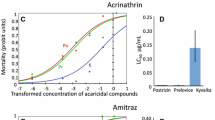Abstract
The insecticidal and repellent effect of the following insecticides was investigated against stored product insects: bioresmethrin; chlorphoxim; fenitrothion; lindane; permethrin; phoxim; pyrethroid-H; rotenone; tetramethrin.
Phoxim, bioresmethrin and fenitrothion showed a strong insecticidal effect onTribolium castaneum; the effect of chlorphoxim and permethrin was very weak; pyrethroid-H, rotenone and tetramethrin revealed no toxic effect.
Tribolium castaneum showed a strong —Oryzaephilus mercator, Sitophilus granarius andTribolium madens to a certain extent — resistance against lindane. The insecticidal effect of lindane was, however, strong againstLasioderma serricorne, Rhizopertha dominica, Stegobium paniceum, Tenebroides mauritanicus, Tribolium confusum.
Lindane, tetramethrin and permethrin revealed a very good — fenitrothion and bioresmethrin a good — repellent effect againstT. castaneum. The repellent effect of lindane was also found againstO. mercator, S. Granarius, St. paniceum andT. madens.
In addition, the repellent effect of the repellent agents was tested onT. castaneum: Mandelic acid ethyl ester; adipinic acid dibutyl ester; benzoic acid. Mandelic acid ethyl ester showed a very good-adipinic acid ditubyl ester and benzoic acid a good — repellent effect on this insect.
Zusammenfassung
Die Insektizid- und Repellentwirkung von folgenden Insektiziden wurde an bestimmten Vorratsschädlingen untersucht: Bioresmethrin; Chlorphoxim; Fenitrothion; Lindan; Permethrin; Phoxim; Pyrethroid-H; Rotenon; Tetramethrin.
Phoxim, Bioresmethrin und Fenitrothion zeigten eine sehr starke Insektizidwirkung gegenTribolium castaneum, die Insektizidwirkung von Chlorphoxim und Permethrin war sehr gering. Pyrethroid-H, Rotenon und Tetramethrin ergaben keine toxische Wirkung.
T. castaneum zeigte eine starke,Oryzaephilus mercator, Sitophilus granarius undTribolium madens in gewissem Grade Widerstand gegenüber Lindan. Die Insektizidwirkung von Lindan war jedoch sehr stark gegenLasioderma serricorne, Rhizopertha dominica, Stegobium paniceum. Tenebroides mauritanicus undTribolium confusum.
Lindan, Tetramethrin und Permethrin hatten eine sehr gute, Fenitrothion und Bioresmethrin eine gute, repellierende Wirkung gegenT. castaneum. Die repellierende Wirkung von Lindan wurde auch beiO. mercator, S. granarius, St. paniceum undT. madens nachgewiesen.
Außerdem wurde die Repellentwirkung der Repellents gegenT. castaneum untersucht: Mandelsäureäthylester zeigte eine sehr gute, Adipinsäuredibutylester und Benzoesäure eine gute repellierende Wirkung gegen diese Schädlingsart.
Similar content being viewed by others
Literaturverzeichnis
Arnold, J. W., 1957: Toxicity and repellency of paradichlorobenzene to larvae of the black carpet beetle. J. Econ. Entom.50 (4), 469–471.
Blow, P. D., 1978: Laboratory evaluation of permethrin against cockroaches and the rust-red flour beetle. Int. Biodeterior. Bull.14 (3), 71–76.
Busvine, J. R., 1962: Insecticide resistance among pests of stored products. Verh. XI. Int. Kongr. Entom. Wien, Band 1960, 220–221.
Cline, L. D., 1978: Penetration of seven common flexible packaging materials by larvae and adults of eleven species of stored-product insects. J. Econ. Entom.71 (5), 726–729.
Cotton, R. T., 1944: Protection of Stored and dried processed foods and seed supplies from insect attack. J. Econ. Entom.37 (3), 380–384.
Curran, T. D., 1976: Seal quality measurement. Modern Packag.49 (1), 30–34.
Dal Monte, G., 1974: Nuove prove sulla resistenza di alcuni materiali da imballo all'attacco di insetti granivori. Ministerio dell'agricoltura e delle Forreste. Direzione Generale dell'Alimentazione. Roma, 48 S.
Dyte, C. E., 1974: Problems arising from insecticide resistance in storage pests. EPPO Bull.4 (3), 275–289.
Gerhardt, P. D., Kindgren, D. L., 1954: Penetration of various packaging films by common stored-product insects. J. Econ. Entom.47 (2), 282–287.
Gerhardt, P. D., Kindgren, D. L., 1955: Insect penetration of films. Mod. Packag.28 (8), 216–219.
Gillenwater, H. B., McGovern, T. P., McDonald, L. L., 1981: Repellents for adultTribolium castaneum: Alkynyl Mandelates. J. Georgia Entom. Soc.16 (1), 106–112.
Goodhue, L. D., Howell, D. E. 1960: Repellents and attractants in pest control operations. Pest Control28, 44, 46, 48, 50.
Khan, M. A., Wohlgemuth, R., 1980: Diäthyltoluamid als Repellent gegen Vorratsschädlinge. Anz. Schädlingskde., Pflanzenschutz, Umweltschutz53 (8), 126–127.
Khan, M. A., 1981: Repellents gegen vorratsschädliche Insekten. Anz. Schädlingskde., Pflanzenschutz, Umweltschutz54 (5), 70–77.
Khan, M. A., 1982 a: Further investigations on repellency of chemical compounds to stored product insect pests. J. Stored Prod. Res. (In press).
Khan, M. A., 1982 b: Repellency of chemical compounds to stored product insect pests — A review of literature. Mitt. Biol. Bundesanst., Berlin-Dahlem, H.206, 34 pp.
Khan, M. A., 1982c: Die Widerstandsfähigkeit von Mono- und Verbundfolien gegen Vorratsschädlinge. Z. angew. Ent.94 (2), 127–133.
Khan, M. A., Wohlgemuth, R., Noack, S., 1983: Untersuchungen zum Schutz verpackter Nahrungs- und Genußmittel gegen Vorratsschädlinge. Mitt. Biol. Bundesanst., Berlin-Dahlem (Im Druck).
Kumar, V., Morrison, F. O., 1963: The susceptibility levels of certain stored product pest populations to chemicals used for their control. Phytoprotection44, 101–105.
McDonald, L. L., Guy, R. H., Speirs, R. D., 1970: Preliminary evolution of new candidate materials as toxicants, repellents and attractants against stored product insects. 1. USDA MKTg. Res. Rep.882, 1–8.
McGovern, P. T., Gillenwater, B. H., McDonald, L. L., 1979: Repellents for adultTribolium confusum: Amides of three heterocyclic amides. J. Georgia Entom. Soc.14 (2), 166–174.
Schmidt, H. U., 1979: Die mechanische Widerstandsfähigkeit von Packstoffen (Folien) gegen den Getreidekapuziner (Rhizopertha dominica F.), den Brotkäfer (Stegobium paniceum L.) den Rotbraunen Reismehlkäfer (Tribolium castaneum Hbst.) und die Larven der Dörrobstmotte (Plodia interpunctella Hbn.). Material und Organismen14 (4), 241–258.
Srivastava, A. S., Srivastava, J. L., 1970: Residual toxicity of lindane and malathion againstLeamophloeus minutus Oliv. Z. angew. Entom.66 (1), 100–102.
Weidner, H., 1962: Die Bedeutung der Verpackung im Vorratsschutz gegen Insekten. Süßwaren6 (18), 1074–1087.
Author information
Authors and Affiliations
Additional information
Mit 4 Tabellen
Diese Arbeit wurde gefördert im Rahmen der Sachbeihilfe des Arbeitskreises Industrielle Forschungsvereinigungen e. V. (AIF) am Dr.R. Wohlgemuth, Biologische Bundesanstalt für Land-und Forstwirtschaft, Institut für Vorratsschutz, Berlin-Dahlem, zum Thema “Untersuchungen zum Schutz verpackter Nahrungs-und Genußmittel gegen Befall durch Vorratsschädlinge”.
Rights and permissions
About this article
Cite this article
Khan, M.A. Wirksamkeit von Insektiziden und Repellents gegen Vorratsschädlinge. Anz. Schadlingskde., Pflanzenschutz, Umweltschutz 56, 25–29 (1983). https://doi.org/10.1007/BF01905984
Issue Date:
DOI: https://doi.org/10.1007/BF01905984




